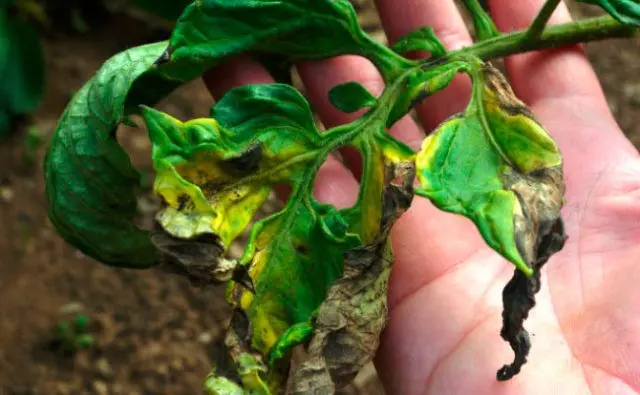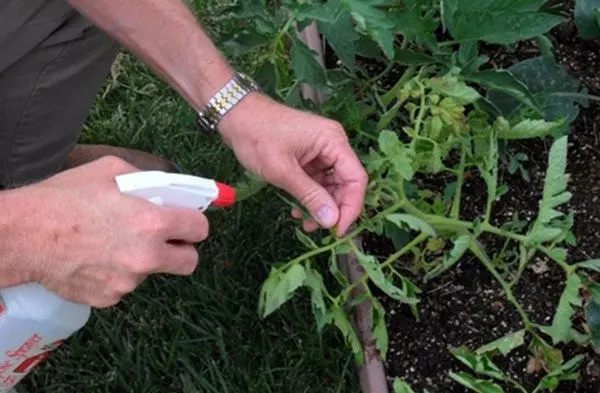Contents
Treatment for diseases is the most important process in the pre-winter preparation of greenhouse soil. It is very important to treat the greenhouse from phytophthora in the fall in order to get a full-fledged crop next year, not damaged by diseases. There are several ways to do this processing, but there are basic rules that must be followed.

Signs of the appearance of phytophthora in the greenhouse
Phytophthora is a dangerous disease that affects many cultivated plants, most often nightshade. Caring for a greenhouse in the fall after late blight requires serious effort to prevent serious complications for the future crop. After harvesting, late blight spores remain in the upper parts of the soil, where they can successfully overwinter until the next season. The first signs of this fungal disease are the appearance of brown spots on the leaves of cultivated plants, as well as a white coating with high humidity indoors.
If you do not fight the disease, then late blight can completely crop tomatoes, potatoes and many other plants. Therefore, processing the greenhouse after phytophthora in the fall is very important in order to destroy all the spores that are in the closed space, as well as on its structure and in the soil.
How dangerous is this disease
Phytophthora fungus eventually spreads to the entire crop. The leaves gradually turn brown, dry and curl. If the gardener is going to save the crop, he often removes green tomatoes from the bush and puts them to ripen. This doesn’t really help, as tomatoes in a crate are just as susceptible to fungus as other fruits. If the space is not treated in the fall, then the mycelium of the fungus will also spread to the next crop and the yield will decrease significantly, up to complete destruction.
How to process a greenhouse after phytophthora in the fall
Preparation for the new season occurs immediately after harvest. It can be processed with special chemicals, as well as biological agents and temperature conditions. You can use both the proposed means separately, and apply a complex effect. Soil treatment from phytophthora in autumn in a greenhouse is necessary in the form of a number of measures both to control and to prevent the disease.
How to deal with late blight in a greenhouse in the fall with chemicals
First of all, it is necessary to properly prepare the closed space after harvesting. Only after preparation can chemicals be used to combat the fungus. For chemical treatment should be used:
- slaked lime;
- bleach;
- concentrated solution of copper sulfate;
- sulfur checkers;
- chemical fungicide.
Each of the presented preparations is recommended to be used correctly in order to treat the greenhouse for the winter from phytophthora:
- Sulfur fumigation. It is carried out with special checkers “Climate”, “Face”, and also “Volcano”. It is described in detail in the instructions how to use these checkers.
- Copper sulfate it is required to dilute in a ratio of 100-150 grams per 10 liters of water. Then, with the composition, whiten all places where pathogenic microflora is observed and there is a risk of infection.
- Slaked lime. Mix 4 kg of freshly slaked lime with 0,5 kg of blue vitriol and 10 liters of water. Whitewash the entire greenhouse, including brickwork and all places where pathogenic flora can form.
- Bleaching powder. Изготавливается раствор из 1 кг сухого вещества на 10 литров воды. Настоять в течение часа и опрыскать все помещение.

In addition to well-known solutions, various universal fungicides are successfully used. They are used strictly according to the instructions that are attached to the fungicide when sold. The most common method is tillage in the greenhouse in autumn with phytosporin.

How to treat a greenhouse after phytophthora in autumn with biological preparations
Biological fungicides can be used to treat small spaces. These drugs are based on the natural ability to suppress pathogenic microflora. But these drugs have their own condition – they work only at a temperature of 12-14 ° C above zero.
The most commonly used drugs are:
- “Trichodermin”;
- “Baktofiton”;
- “Fitosporin”.
The treatment consists in the fact that the drug is dissolved, according to the instructions, in water and the entire room is sprayed with this solution. Spray again after 14 days.
Land cultivation in a greenhouse in autumn from phytophthora
The best option for soil treatment is its change. This is a troublesome business, but it completely eliminates the fungus and for several years. Great for small spaces.
Для проведения такой процедуры ежегодно, иногда по 2 раза в год, снимают 20 см грунта, вывозят его на специально подготовленную площадку. На ней смешивают грунт с сухими листьями, а также добавляют компост. Каждый слой данной заготовки следует прыскать специальными растворами, например, «Трихоплант». Этот грунт снова можно использовать в теплице уже через 2 года. Только он даст гораздо больший урожай и не будет содержать в себе патогенной микрофлоры.
And also sowing green manure, for example, white mustard in the fall before winter, helps a lot. In the spring, mustard will sprout and in one season it will disinfect all the soil in the greenhouse, as it will suppress all pathogenic microflora.
Обработка теплицы из поликарбоната осенью от фитофторы включает и полив ярко-розовым раствором марганцовки с последующим перекопом почвы на штык лопаты и высевом сидератов.
The temperature method of dealing with phytophthora in the greenhouse
Like many other biological species, the phytophthora fungus is able to live only in strictly defined temperature conditions. Therefore, in order to get rid of pathogenic microflora, it is necessary to radically change the temperature regime in the greenhouse.
After harvesting, with the onset of frost and cold weather, it is recommended to clear the greenhouse of spores by freezing. To do this, it is necessary to open the greenhouse space for several days at the lowest possible temperatures. If snow falls, it is recommended to remove it from the soil surface, since zoospores can survive under a layer of snow and become active again in spring.
And also pathogenic microflora does not tolerate temperatures above 35 ° C. In autumn, such a temperature cannot be created for a greenhouse, and therefore it is good to treat it with boiling water.
How to get rid of late blight in a greenhouse in autumn: a set of measures
In order to fully protect your crop next year, experts recommend treating the greenhouse in the fall with a set of measures. First of all, after harvesting, prepare the soil. First you need to remove all the tops, old foliage, as well as broken structures, the remains of the twine on which the plants were tied.
After that, depending on the material from which the room is made, disinfection is carried out. You can use sulfur checkers, slaked lime and other disinfection methods.
It does not hurt to treat the greenhouse with phytosporin in the fall, especially if the infection was large-scale.
Greenhouse care in the fall after late blight is excellent if store-bought fungicides are added to the ground, but the instructions and all proportions should be strictly followed so as not to harm a person. All spraying procedures should be carried out in a respiratory mask so that pesticides do not enter the respiratory tract.

Preventive measures against phytophthora in the greenhouse
There are several rules, following which you can avoid infection with phytophthora crops in the greenhouse:
- do not plant cultivated plants too densely;
- it is recommended to mulch the soil;
- bushes must be tied up without fail;
- remove stepsons and excess leaves.
If all the necessary preventive measures are observed, as well as when creating the right microclimate, the gardener will be able to avoid the appearance of pathology and damage to the crop.
Conclusion
Treating a greenhouse from phytophthora in the fall is an important and necessary task, especially if there are signs of infection in the greenhouse this season. Processing can be carried out using chemicals, biological fungicides, as well as temperature conditions. The processing of the greenhouse from phytophthora in the fall is well shown in the video, so even a novice gardener can handle it.









